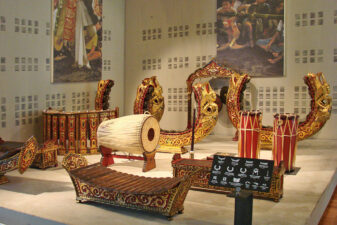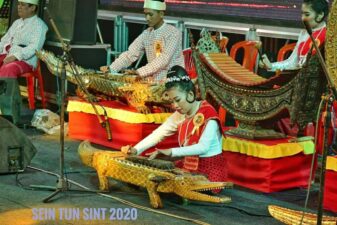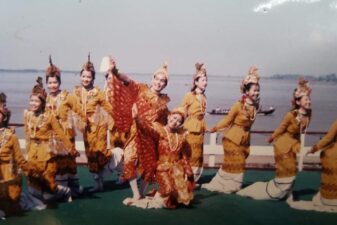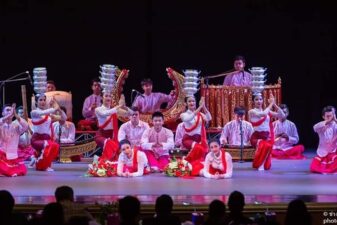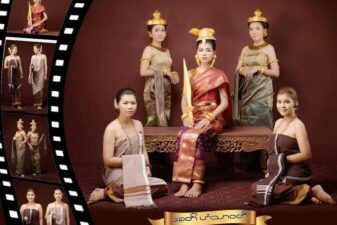Language
The Mon language belongs to the Monic group within the Austroasiatic languages, also known as the Mon–Khmer language family. It shares a close relationship with the Nyah Kur language and has more distant connections to Khmer and Vietnamese. Its writing system is rooted in Indic scripts, representing one of the earliest documented vernacular languages in Mainland Southeast Asia.
The influence of the Mon language extends to various languages in the region. Both the Tai Tham alphabet and Burmese alphabet have evolved from the Mon script. The Tai Tham alphabet is predominantly used for the Northern Thai, Tai Lue, Khün, and Lao Tham languages. Meanwhile, the Burmese alphabet finds application in the Burmese, Shan, S’gaw Karen, and other languages.
In historical contexts, the Tai people adopted the Mon alphabet, developing it into their own writing systems, such as the Tai Tham alphabet, for the Thai Yuan people in northern Thailand.
While Thai drew more influences from the Old Khmer alphabet than the Mon, a considerable portion of today’s Thai vocabulary has roots in the Mon language. Similarly, Burmese has incorporated vocabulary from Mon, particularly in areas such as administration, architecture, cloth, cuisine, and flowers.
Presently, the Mon language holds recognition as an indigenous language in both Myanmar and Thailand. However, due to a decline in the number of Mon language speakers in recent decades, UNESCO’s 2010 Atlas of the World’s Languages in Danger categorizes Mon as a “vulnerable” language. The language is estimated to have 800,000 to 1,000,000 speakers.
Culture
The emblem of the Mon people is the hongsa (Mon: ဟံသာ, [hɔŋsa]), a mythological water bird often depicted as a swan. Referred to by its Burmese name, hintha (Burmese: ဟင်္သာ, IPA: [hɪ́ɰ̃θà]), or its Thai name, hong (หงส์), the hongsa holds cultural significance. It serves as the official symbol for Myanmar’s Bago Region and Mon State, both being historically significant Mon strongholds. Additionally, the hongsa is adopted as the city symbol for Thailand’s Pak Kret City, an area with a rich Mon historical presence.
- Mon State Flag
- Mon People’s Flag
- Mon National Flag
- Hongsa in Thai-Mon Style
The cultural and traditional heritage of the Mon people encompasses spiritual dances and a variety of musical instruments. Among these are the kyam, also known as the “crocodile xylophone,” the la gyan hsaing gong chime, the saung harp, and a flat stringed instrument. Mon dances are typically performed in formal theater settings or occasionally in informal districts within villages. These dances are accompanied by background music, featuring a circular arrangement of tuned drums, claps, the crocodile xylophone, gongs, flute, flat guitar, harp, violin, and more.
Pottery
For over two centuries, the Mon people in Thailand have engaged in the art of pottery. Their ancestors settled in Koh Kret and Nakhon Sawan, employing their pottery-making skills to sustain themselves in both locations. Renowned for its superior clay, the region is synonymous with Mon pottery, which includes containers and decorative items, serving as a testament to their rich heritage and craftsmanship. Crafted from porous earthenware in shades of light orange to red, the pottery boasts unique designs inspired by nature. Despite technological progress, the Mon community continues to preserve and pass down this traditional handicraft.
Floral
Umbrellas The tradition of floral umbrellas in Mon culture dates back to ancient times and has a significant historical footprint. Inscriptions discovered in northern Thailand trace the use of umbrellas and palm-leaf manuscripts in Mon religious ceremonies during the Hariphunchai Kingdom, spanning from the 7th to the 13th century. Presently, floral umbrellas persist in various ceremonies and festivals within Mon communities, playing integral roles in events such as weddings, ordinations, and temple fairs. These umbrellas remain a cherished aspect of Mon cultural heritage, connecting the present to a rich historical legacy.
Mon literature constitutes a diverse collection of creations by the Mon people in Myanmar and Thailand, encompassing chronicles, poems, songs, folktales, and religious texts. The legendary tale “Lik Smin Asah” recounts the founding of the city of Pegu, while the well-known Mon folktale “Sangada” has been adapted into Thai and Laotian literature as “Sangsinchay.” The chronicle “Rājādhirāj” or “Razadarit,” detailing the life of the Mon king, has been translated into Burmese as “Razadarit Ayedawbon” and into Thai as “Rachathirat.” In both Myanmar and Thailand, Mon literature is highly regarded as an essential cultural heritage, valued for its cultural and historical significance.
The religious landscape of the Mon people is characterized by a blend of spiritual beliefs and the practice of Theravada Buddhism, with the majority embracing this amalgamation. Prior to the widespread adoption of Buddhism, the Mon Kingdom adhered to three traditional beliefs, which included reverence for Kalok (spirits), Isi (holy hermits), and Hinduism. Within the realm of Kalok, the Mon people traditionally acknowledged various manifestations, such as family/clan kalok, guardian kalok associated with homes, towns, villages, farms, forests, and mountains. Kalok is perceived as a spirit, demon, or immaterial being capable of assuming visible forms.
Festivals celebrating Mon culture hold a significant place within the Mon communities in Myanmar and Thailand. Among these, the Loi Hamod Festival stands out, tracing its origins to the Hariphunchai era and believed to be the precursor to the Loi Krathong Festival. While some Mon communities in Lamphun Province still observe a variation called “Jong Gring,” derived from other Mon cultural practices and meaning “Loi Krathong,” it distinguishes itself by resembling the ancient “Loi Hamod” tradition of Mon people in Hariphunchai. This involves offering both fresh and dried foods, lighting lanterns, and floating small krathongs.
Another notable Mon festival is the Luknoo Festival, marking the end of the monsoon season and the onset of the new year. It includes the launch of homemade rockets, food offerings to spirits, and cultural activities like music, dance, and games. This festival plays a crucial role in preserving Mon traditions, fostering community bonds, and ushering in good fortune for the upcoming year.
The Mon Floating Boat Festival is a traditional celebration during the Mon New Year, featuring boat races, music, dance, feasting, lantern releases, and gift exchanges. It serves as a unifying event for the Mon community, allowing them to make offerings for peace and prosperity.
The Hae Hang Hong Tong Ta Khab Festival, also known as the Tawai Tong Ta Khab Festival, holds significance among the Mon people in Thailand, particularly in Pathum Thani, Pak Kret, and Phra Pradaeng. Taking place during the Songkran festival, it involves a vibrant parade of flags moving toward the Hongsa Pole to pay tribute to the Buddha. Prior to the festival, a collective effort is made to sew and decorate the flags.
During the Songkran festival in Thailand, residents of Phra Pradaeng District host unique Mon traditional ceremonies and folklore performances. These festivals and traditions exemplify the rich cultural heritage of the Mon people, acting as a vital means to transmit their history and customs to future generations.
Mon women don the traditional shawl-like Sbai, known as Yat Toot in the Mon language, draped diagonally across the chest, covering one shoulder with one end cascading behind the back. This distinctive tradition sets Mon women apart from the other 134 ethnic groups in Myanmar. Archaeological evidence from the Dvaravati era depicts Dvaravati ladies wearing what appears to be a piece of Sbai hanging from their shoulders, reinforcing the continuity of this tradition. The Mon people in Myanmar and Thailand today trace their lineage back to the Dvaravati era.
In Myanmar, Mon men attire themselves in clothing similar to the Bamars, while those residing in Thailand have embraced Thai-style garments. The evolution of Mon clothing reflects a combination of dynastic traditions and external influences.
Thanaka, a yellowish-white cosmetic paste made from ground bark, finds extensive use among the Mon people in Myanmar. Applied to the face, arms, and legs, Thanaka serves as both sun protection and a beautifying agent for the skin. Rooted in Mon culture for centuries, Thanaka remains a vital component of traditional beauty and skincare practices in the country.
Mon culinary traditions have significantly shaped both Burmese and Central Thai cuisines today. Several dishes that enjoy popularity in Myanmar (Burma) and Thailand trace their origins back to the Mon culinary heritage. Notable examples include Htamanè (ထမနဲ) in Myanmar, and Khanom chin and Khao chae in Thailand.
During the Thingyan (Songkran) Festival in the summer, the Mon people indulge in a traditional dish served with rice soaked in cool candle-and-jasmine-scented water. This dish, known as Khao chae (ข้าวแช่) in Thailand and considered “royal cuisine,” has its roots in Mon culinary practices. In Myanmar, the dish is aptly named Thingyan rice (သင်္ကြန်ထမင်း) as it is a significant part of their merit-making during the Thingyan festival.
Similar to Cambodian, Lao, Thai, and Vietnamese cuisines, Mon culinary delights also incorporate fermented fish seasoning. This shared culinary element adds a distinct and flavorful touch to the rich tapestry of Mon cuisine.
Games originating from Mon culture have significantly influenced both Myanmar and Thailand. Notably, Len Saba (lit. ‘saba tossing game’; Mon: ဝိုင်မ်ဟနဂ်; Burmese: ဂုံညင်းဒိုး), Lor Kon Krok (Rolling a Mortar Bottom), and Mon Son Pa (Mon Hides a Cloth) are among the most renowned traditional children’s games within the Mon heritage. These games have received official recognition as Intangible Cultural Heritage by UNESCO.






